Recent Posts
The Importance of Documenting Water Damage for Insurance Claims: Expert Tips from SERVPRO®
3/31/2025 (Permalink)
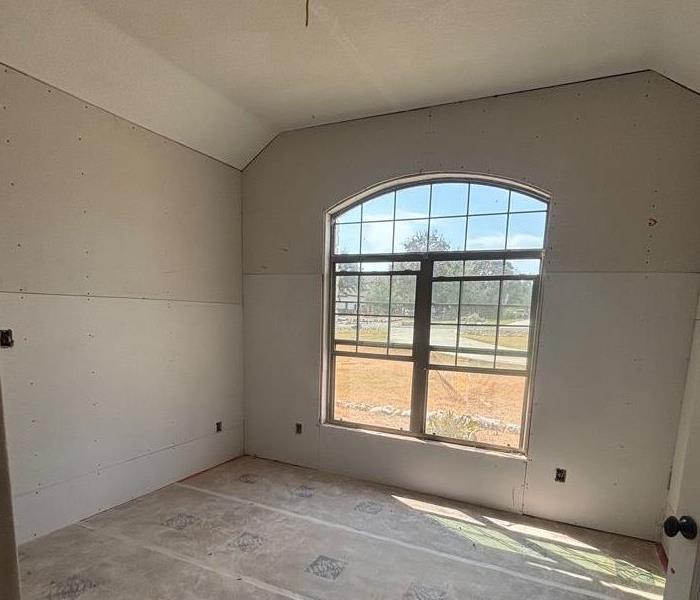 Water damage can be an overwhelming experience for any property owner, but documenting the damage is crucial for a successful insurance claim.
Water damage can be an overwhelming experience for any property owner, but documenting the damage is crucial for a successful insurance claim.
Water damage can be an overwhelming experience for any property owner, but properly documenting the damage is crucial for a smooth and successful insurance claim. Whether caused by a burst pipe, roof leak, or flooding, water damage claims require clear and thorough evidence to ensure you receive fair compensation for repairs.
At SERVPRO®, we understand how stressful the claims process can be, and we’re here to help. This guide will walk you through the importance of documenting water damage and provide expert tips to ensure your insurance claim is as seamless as possible.
Why Proper Documentation Matters for Insurance Claims
When disaster strikes, insurance companies require proof of the damage before approving your claim. Insufficient or unclear documentation can lead to claim delays, partial compensation, or even denial. Properly recording the extent of water damage strengthens your case and helps adjusters accurately assess the costs of repairs.
Key Reasons to Document Water Damage Thoroughly
- Speeds Up the Claims Process – The more detailed and organized your evidence is, the faster the insurance company can evaluate your claim.
- Ensures Fair Compensation – Without proper documentation, an adjuster may underestimate the repair costs, leading to lower reimbursement.
- Prevents Disputes with Insurers – Clear records provide undeniable proof of the damage, reducing the risk of claim disputes or denial.
- Creates a Reliable Record for Future Issues – If further damage arises due to the initial water intrusion, having thorough documentation can support additional claims.
How to Document Water Damage for an Insurance Claim
Proper documentation involves more than just taking a few pictures. Here’s a step-by-step approach to ensure you capture all the necessary details.
1. Take Clear Photos and Videos
Visual evidence is the strongest proof you can provide. Follow these guidelines when capturing water damage:
- Take photos from multiple angles – Capture close-ups and wide shots to show the full extent of the damage.
- Include timestamps – Use your smartphone or camera settings to add timestamps to photos and videos.
- Document water levels – If flooding is involved, show how high the water has risen inside your property.
- Capture affected belongings – Photograph damaged furniture, electronics, flooring, and personal items to support your claim.
2. Record Detailed Written Descriptions
In addition to visual evidence, written documentation helps paint a full picture of the damage. Make sure to:
- Describe what caused the water damage (e.g., broken pipe, storm, appliance leak).
- List the areas affected, including walls, floors, ceilings, and structural components.
- Include estimated timelines—when the damage occurred and when you discovered it.
3. Save Repair Estimates and Receipts
Gather all professional estimates, invoices, and receipts related to water damage restoration. This includes:
- Initial damage assessment from a restoration company like SERVPRO.
- Costs for emergency mitigation services (e.g., water extraction, drying equipment rental).
- Repair and reconstruction estimates from contractors.
- Receipts for damaged items that need replacement.
4. Maintain Communication Records
Keep a log of all conversations with your insurance company, including:
- The date and time of each discussion.
- The name of the representative you spoke with.
- Notes on what was discussed and any instructions given.
This documentation ensures there’s a record of every step in case any disputes arise.
FAQs: Water Damage Documentation for Insurance Claims
Q: How soon should I start documenting water damage?
A: Immediately. The sooner you begin taking photos and notes, the better. This prevents questions about when the damage occurred and ensures nothing is overlooked.
Q: What if I already started cleaning up before taking pictures?
A: If possible, try to document the damage before cleanup. If you've already started, take pictures of anything you’ve removed and keep any damaged items until an adjuster assesses them.
Q: Do I need a professional damage assessment?
A: While not always required, having SERVPRO or another professional restoration company provide an assessment can add credibility to your claim and ensure all damage is properly evaluated.
Q: Should I document small water damage incidents?
A: Yes. Even minor water damage can worsen over time, leading to costly repairs. Keeping records of any incident helps protect you in case of future claims.
Q: Can SERVPRO assist with the insurance claims process?
A: Absolutely! Our team works closely with insurance companies, providing detailed documentation and professional assessments to streamline your claim.
Trust SERVPRO to Help with Water Damage and Insurance Claims
Dealing with water damage is stressful enough without having to worry about insurance claim complications. By documenting the damage properly, you increase your chances of receiving fair compensation while minimizing claim delays.
At SERVPRO, we’re here to help. From emergency water removal to detailed damage assessments, our team works alongside you and your insurance company to ensure a smooth restoration process. If you’ve experienced water damage, contact SERVPRO today for expert assistance.
Mold in Basements: Expert Waterproofing and Mold Prevention Tips from SERVPRO®
11/13/2024 (Permalink)
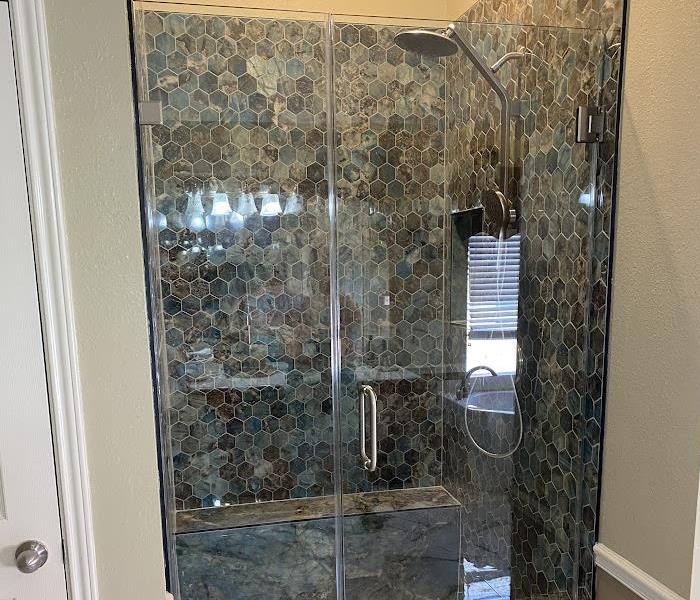 Understanding how to prevent mold in your basement through proper waterproofing techniques can save you from costly repairs and structural damage.
Understanding how to prevent mold in your basement through proper waterproofing techniques can save you from costly repairs and structural damage.
Mold in basements is a common issue that many homeowners in New Braunfels, TX, face, especially in areas prone to heavy rainfall or moisture accumulation. With basements being below ground level, they are more susceptible to dampness and water intrusion, making them an ideal breeding ground for mold. Understanding how to prevent mold in your basement through proper waterproofing techniques can save you from costly repairs and structural damage.
In this blog, we'll dive into expert insights on waterproofing and mold prevention for your basement, ensuring your home remains safe, dry, and mold-free.
Why Mold Grows in Basements
Basements provide a perfect environment for mold growth. Mold thrives in areas that are damp, dark, and poorly ventilated—all characteristics often found in basements. Moisture can come from various sources, including groundwater seepage, high humidity, plumbing leaks, and poor drainage systems around the home.
A statistic by the Environmental Protection Agency (EPA) highlights the prevalence of mold issues, noting that approximately 50% of U.S. homes have dampness or water problems that can lead to mold. This reinforces the importance of implementing strategies to prevent moisture and mold from taking hold in your basement.
Expert Tips for Waterproofing and Mold Prevention
When it comes to preventing mold, waterproofing your basement is crucial. Here are some expert tips to ensure your basement remains dry and mold-free:
1. Seal Cracks and Openings
Even small cracks in your basement walls or floor can allow water to seep in, creating an environment conducive to mold growth. Use a high-quality waterproof sealant to fill in cracks and gaps, especially around windows and joints where walls meet the foundation. This can help prevent water intrusion during storms or heavy rain.
2. Install a Sump Pump
A sump pump is an essential tool for keeping water out of your basement. It works by collecting water that accumulates in a sump basin and pumping it away from your home. Installing a sump pump can significantly reduce the risk of flooding, especially if your home is in an area prone to heavy rainfall or a high water table.
3. Ensure Proper Drainage
Make sure the ground surrounding your home slopes away from the foundation. Poor grading can cause water to pool near your home, eventually seeping into your basement. Installing gutters and downspouts that divert water at least six feet away from your foundation can also help prevent moisture from accumulating around the perimeter of your house.
4. Use a Dehumidifier
A dehumidifier is an excellent way to control humidity levels in your basement. Mold grows when relative humidity exceeds 60%, so keeping your basement’s humidity below this level is critical. By reducing moisture in the air, you can prevent the growth of mold and mildew.
5. Install Vapor Barriers
Vapor barriers are materials (often made from polyethylene) that block moisture from entering your basement through walls and floors. These barriers can be installed during construction or as part of a basement finishing project to keep moisture from permeating through concrete or other porous materials.
6. Regularly Inspect for Leaks
Small leaks in plumbing pipes or fixtures can lead to long-term moisture problems if left unchecked. Make it a habit to regularly inspect any exposed plumbing in your basement for signs of leaks. Catching leaks early can prevent water from accumulating and causing mold growth.
Additional Steps for Long-Term Mold Prevention
In addition to the tips mentioned above, here are some extra steps you can take to ensure your basement remains mold-free in the long run:
- Monitor Humidity Levels: Invest in a hygrometer to measure the humidity in your basement. This will help you stay informed and take action if levels begin to rise.
- Waterproof Basement Walls: Apply a waterproofing membrane or paint to your basement walls as an added layer of protection. This will help keep moisture out while providing a mold-resistant surface.
- Perform Routine Maintenance: Regularly clean and maintain your basement by checking for water stains, damp areas, or musty odors. Early detection is key to preventing mold from spreading.
The Importance of Professional Mold Remediation
If you suspect mold has already developed in your basement, professional remediation is crucial. SERVPRO specializes in mold removal and remediation services, providing homeowners with peace of mind. Our team of experts will assess the extent of the mold issue, address the underlying moisture problem, and restore your basement to a mold-free condition.
Conclusion
Preventing mold in your basement is an essential aspect of home maintenance. By implementing these expert waterproofing tips, you can significantly reduce the risk of water damage and mold growth. From sealing cracks to installing a sump pump, each preventive measure plays a vital role in keeping your basement dry and safe.
If you're ever unsure about how to properly address water or mold issues, don't hesitate to contact SERVPRO for professional assistance. With our extensive experience in mold remediation and waterproofing, you can trust us to protect your home from mold-related problems.
How Water Damage Can Drive Up Your Utility Bills
10/16/2024 (Permalink)
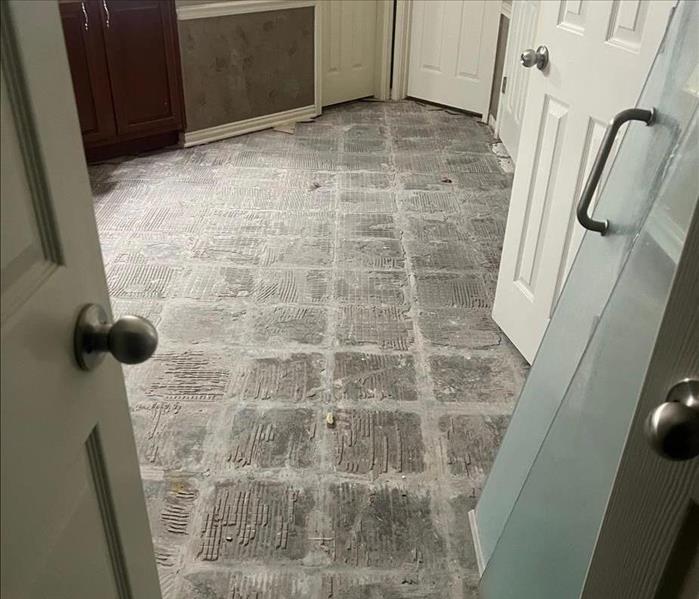 If you suspect water damage or want to ensure your property is protected, reach out to SERVPRO of Schertz Central, Cibolo, Seguin, Gonzales.
If you suspect water damage or want to ensure your property is protected, reach out to SERVPRO of Schertz Central, Cibolo, Seguin, Gonzales.
Water damage isn’t just a hassle—it can seriously impact your home and finances. It’s important to be aware of the hidden costs that water damage can bring. Beyond the obvious repairs, water damage can unexpectedly drive up your utility bills. Let’s dive into how this happens and what you can do to keep your costs in check.
Increased Heating and Cooling Costs
One of the first ways water damage can hit your wallet is through higher heating and cooling bills. When water gets into your home, it can damage insulation, making it less effective. Good insulation keeps your home warm in winter and cool in summer, but when it’s damaged, your HVAC system has to work overtime to maintain a comfortable temperature.
Why Insulation Matters for Energy Efficiency
Heating and cooling account for about 48% of the energy use in a typical U.S. home, according to the U.S. Energy Information Administration. If your insulation has been compromised by water damage, your home will lose heat faster in the winter and gain heat more easily in the summer, leading to higher energy bills. If you’ve had water damage, it’s crucial to check your insulation and replace it if needed.
Water Waste and Higher Water Bills
Water damage often leads to leaks, and these can go unnoticed for a while, causing water waste and higher water bills. Even a small, steady leak can add up over time, and in some cases, these leaks may be hidden behind walls or under floors.
Spotting Hidden Leaks
Hidden leaks are common after water damage, especially if the damage wasn’t addressed right away. The EPA reports that a leaky faucet dripping at one drip per second can waste over 3,000 gallons of water a year. Just imagine what a hidden pipe leak could do! Regularly checking for signs of leaks, like damp spots on walls or ceilings, can help you catch problems early and avoid high water bills.
Mold Growth and Its Impact on Utility Costs
If water damage isn’t properly handled, it can lead to mold growth, which can affect your home’s energy efficiency. Mold thrives in damp areas and can spread quickly, damaging walls, ceilings, and insulation. As mold spreads, it can make your home less energy-efficient, leading to higher heating and cooling costs.
The Hidden Costs of Mold
Beyond the expense of mold removal, mold can reduce your home’s energy efficiency. Mold can break down insulation and create cold spots, making your heating system work harder. This inefficiency can drive up your energy bills and lead to more costly repairs if left unchecked.
Taking Action After Water Damage
Water damage can lead to higher utility bills, expensive repairs, and a lot of stress. In New Braunfels, TX, where heavy rains and humidity are common, it’s essential to be proactive in preventing and dealing with water damage. Regular inspections, quick repairs, and proper maintenance can help you avoid the hidden costs water damage can bring.
If you suspect water damage or want to ensure your property is protected, reach out to SERVPRO of Schertz Central, Cibolo, Seguin, Gonzales. Our team can assess the situation, provide expert restoration services, and help you prevent further damage, ultimately saving you money and ensuring your home stays safe and comfortable.
Understanding the Aftermath of Storm Surge and Flood Damage
9/11/2024 (Permalink)
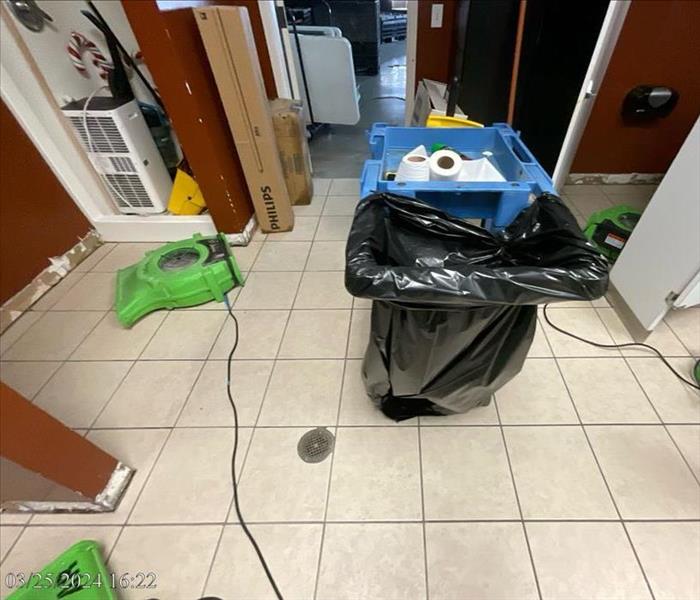 SERVPRO is here to help you understand the aftermath and how to tackle the challenges that come with storm surges and flood damage.
SERVPRO is here to help you understand the aftermath and how to tackle the challenges that come with storm surges and flood damage.
When storms hit in New Braunfels, Texas, the destruction can be devastating, particularly from storm surges and flood damage. These natural disasters wreak havoc on homes and businesses, leaving behind a trail of destruction that can take months or even years to recover from. SERVPRO® is Here to Help® you understand the aftermath and how to tackle the challenges that come with storm surges and flood damage.
The Impact of Storm Surge and Flooding
Storm surges occur when strong winds from a storm push water onto the shore, causing sudden and severe flooding. This can lead to significant property damage, endangering lives and disrupting communities. Flood waters can infiltrate homes, businesses, and infrastructure, leading to extensive water damage, mold growth, and structural issues.
Flood Damage in Texas: A Startling Statistic
Texas is particularly vulnerable to flooding. In fact, a recent report highlighted that "Texas leads the nation in flood-related fatalities and property damage," according to the Texas Water Development Board. The financial impact is equally alarming, with flood damage costing Texans an estimated $1 billion annually. This statistic underscores the critical need for effective flood damage response and mitigation strategies.
Immediate Steps to Take After a Flood
The aftermath of a flood can be overwhelming, but knowing the right steps to take can help mitigate damage and speed up recovery.
- Ensure Safety First: Before re-entering your property, ensure it is safe. Check for structural damage, gas leaks, and electrical hazards.
- Document the Damage: Take photographs and videos of the damage for insurance claims.
- Remove Water Quickly: The longer water sits, the more damage it can cause. Use pumps, wet vacuums, and dehumidifiers to remove water and moisture.
- Prevent Mold Growth: Mold can start growing within 24-48 hours. Remove wet materials and dry out your space as quickly as possible.
- Call the Professionals: SERVPRO specializes in flood damage restoration. Our team of experts can assess the damage, provide comprehensive cleanup, and restore your property to its pre-flood condition.
Long-Term Flood Mitigation Strategies
To protect your property from future floods, consider these long-term strategies:
- Elevate Utilities: Place electrical panels, appliances, and heating systems above the potential flood level.
- Install Sump Pumps: A sump pump can help remove water from your basement.
- Seal Cracks and Openings: Prevent water from entering your home by sealing cracks in walls, floors, and foundations.
- Improve Drainage: Ensure that your property has proper drainage systems to divert water away from your home.
Conclusion
Dealing with the aftermath of storm surge and flood damage can be daunting, but with the right approach and professional help from SERVPRO, recovery is possible. Understanding the impact, taking immediate action, and implementing long-term solutions are key to protecting your property and ensuring safety in the future. Remember, SERVPRO is Here to Help® you navigate through these challenging times with expert care and dedication.
Preventing Catastrophe: The Dangers of Gas Leaks and How to Detect Them
8/14/2024 (Permalink)
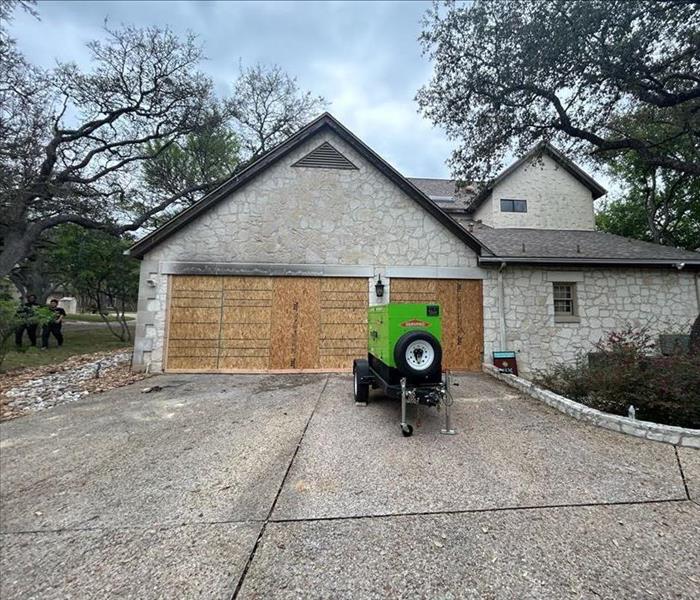 We explore the hazards associated with gas leaks and offer practical advice on identifying them early.
We explore the hazards associated with gas leaks and offer practical advice on identifying them early.
Gas leaks pose significant risks to both health and safety, making it crucial to understand their dangers and detection methods. In this blog, we explore the hazards associated with gas leaks and offer practical advice on identifying them early to protect your home and loved ones in New Braunfels, TX.
The Hidden Dangers of Gas Leaks
Gas leaks can have devastating consequences if not detected and addressed promptly. The primary dangers include:
Fire and Explosion Hazards
Gas is highly flammable, and even a small leak can lead to catastrophic fires or explosions. Common ignition sources include:
- Electrical sparks: Turning on a light switch or using an electrical appliance can ignite leaked gas.
- Open flames: Matches, lighters, and even pilot lights on stoves or heaters can cause a fire.
How to Detect Gas Leaks Early
Early detection of gas leaks is essential to prevent disasters. Here are some key methods to identify a gas leak in your home:
Smell
Natural gas is odorless, but utility companies add a distinctive rotten egg smell (mercaptan) to make leaks detectable. If you notice this odor, evacuate immediately and contact your gas company.
Listen
A hissing or whistling sound near gas appliances or pipelines may indicate a leak. If you hear such sounds, it's crucial to take action immediately.
Visual Signs
Look for visible signs of a gas leak, such as:
- Dead or dying plants: Indoor plants suddenly wilting or dying could indicate a gas leak.
- Bubbles in water: If you see bubbles forming in standing water or puddles near your home, it might be a sign of a gas leak.
Gas Detectors
Installing gas detectors in your home is a proactive way to monitor for leaks. These devices can alert you to the presence of gas before it becomes a significant hazard.
What to Do If You Suspect a Gas Leak
If you suspect a gas leak, take the following steps immediately:
- Evacuate: Leave the area quickly and ensure everyone in the building does the same.
- Avoid sparks: Do not use electrical appliances, light switches, or open flames.
- Call for help: From a safe location, contact your gas company or emergency services to report the leak.
Understanding the dangers of gas leaks and knowing how to detect them can save lives and prevent property damage. Stay vigilant and take proactive measures to protect your home. For professional assistance with gas leaks and other emergency restoration services, trust SERVPRO® to provide expert solutions and peace of mind.
Keeping Employees Safe During Mold Removal
7/19/2024 (Permalink)
Mold removal can be a necessary task in workplaces where mold growth poses risks or compromises indoor air quality. However, ensuring the safety of employees during the mold removal process is paramount. Mold removal procedures can expose workers to potential hazards,, including mold spores and mycotoxins, as well as chemicals used in cleaning and disinfection. In this blog, we'll explore some essential steps to keep employees safe during mold removal in the workplace.
Conduct a Risk Assessment
Before beginning mold removal activities, conduct a thorough risk assessment to identify potential hazards and develop appropriate control measures. Consider factors such as the extent of mold growth, the type of mold present, the presence of moisture or water damage, and the accessibility of the affected areas.
Provide Training and Education
Ensure that employees involved in mold removal activities receive proper training and education on mold hazards, safety precautions, and correct removal procedures. Training should cover topics such as the use of personal protective equipment (PPE), proper handling and disposal of contaminated materials, and techniques for minimizing exposure to mold spores.
Use Personal Protective Equipment (PPE)
Provide employees with appropriate personal protective equipment (PPE) to minimize exposure to mold and related hazards. PPE may include:
- Respiratory protection, such as N95 respirators or half-face respirators with P100 filters, to prevent inhalation of mold spores.
- Gloves, goggles, and protective clothing to prevent skin contact with mold and cleaning chemicals.
- Shoe covers or disposable booties to prevent tracking mold spores to other areas.
Implement Engineering Controls
Implement engineering controls to minimize employee exposure to mold spores and contaminants. Engineering controls may include:
- Containment barriers, such as plastic sheeting or containment tents, to isolate the work area and prevent the spread of mold spores to other parts of the building.
- Negative air pressure systems and HEPA air scrubbers to remove airborne mold spores and maintain indoor air quality.
- Ventilation systems to ensure adequate airflow and ventilation during mold removal activities.
Use Safe Work Practices
Promote safe work practices to minimize the risk of accidents and injuries during mold removal. Encourage employees to:
- Work in well-ventilated areas whenever possible.
- Avoid eating, drinking, or smoking in areas where mold removal is taking place.
- Wash hands and exposed skin thoroughly after handling mold-contaminated materials.
- Use caution when handling and moving equipment and materials to prevent trips, slips, and falls.
Conduct Regular Inspections and Maintenance
Implement a regular inspection and maintenance program to identify and address conditions conducive to mold growth, such as water leaks, high humidity levels, and poor ventilation. Addressing these issues promptly can help prevent mold problems from recurring in the future.
Keeping employees safe during mold removal in the workplace requires careful planning, proper training, and adherence to safety protocols. By prioritizing employee safety, workplaces can create a healthy and productive environment for all employees.
Protecting Your Pets from Water Damage-Related Hazards
6/13/2024 (Permalink)
As a responsible pet owner, you want to keep your furry friends safe from harm. One of the most overlooked hazards that can affect pets is water damage in your home. Whether it's caused by flooding, plumbing issues, or leaks, water damage, here's how you can protect your pets from water damage and keep them safe.
1. Keep an Eye on Your Home
Regularly inspect your home for signs of water damage. Look for damp spots, peeling paint, or any unusual odors, especially in areas like basements, bathrooms, and kitchens. Early detection can help prevent further damage and keep your pets safe from harmful mold and mildew growth.
2. Prevent Access to Affected Areas
If you discover water damage in your home, block off the affected areas to keep your pets away. Wet or damp areas can become breeding grounds for bacteria and mold, which can be harmful to your pets if ingested or inhaled.
3. Dry Out Water-Damaged Areas
Promptly address any water damage in your home by drying out affected areas. Use fans, dehumidifiers, and open windows to increase airflow and reduce moisture. This can help prevent the growth of mold and mildew, which can be harmful to your pets.
4. Be Cautious of Standing Water
Standing water can pose a significant risk to pets. It can contain harmful bacteria, chemicals, or sharp debris that may injure your pet. Keep your pets away from standing water, and work to drain or remove it as soon as possible.
5. Store Hazardous Materials Safely
Water damage can cause hazardous materials, such as cleaning supplies and chemicals, to become accessible to your pets. Store these materials in secure, elevated areas away from water-damaged spots to prevent accidental ingestion.
6. Maintain Your Plumbing System
Regularly inspect and maintain your plumbing system to prevent leaks and potential water damage. Fix any issues promptly to avoid future complications and protect your pets from hazards.
7. Plan for Emergencies
In the event of a severe flood or water-related emergency, have an evacuation plan in place for you and your pets. Know where your nearest pet-friendly shelter is, and have a kit with essentials such as food, water, and medications ready for your pets.
By taking proactive steps to prevent and address water damage in your home, you can help protect your pets from related hazards. Keeping your pets safe and healthy is an important part of being a responsible pet owner, so make sure to stay vigilant and take necessary precautions.
The Aftermath of Storm Surge and Flood Damage
5/15/2024 (Permalink)
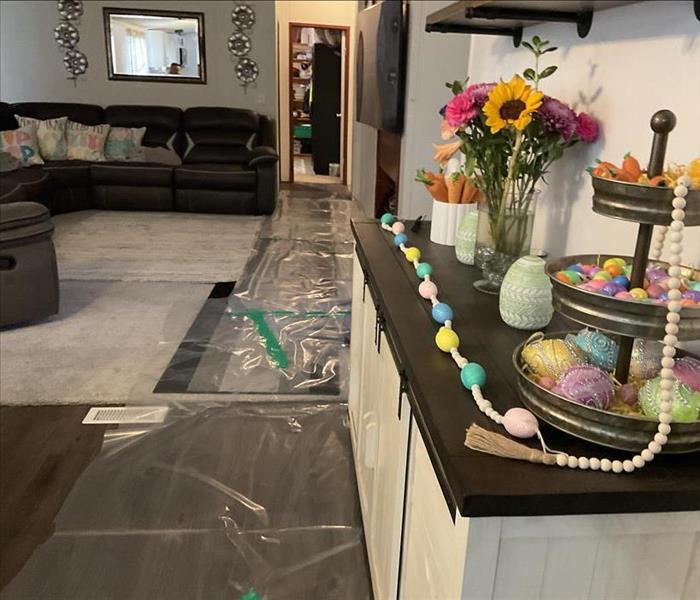 Water damage being worked on by SERVPRO.
Water damage being worked on by SERVPRO.
As storm season rolls in, so does the potential for devastating flooding and storm surges. While these natural occurrences are beyond our control, how we handle the aftermath can make a world of difference. At SERVPRO®, we understand the challenges that come with flood damage and storm surges, which is why we're here to provide guidance and assistance during these trying times.
Understanding the Impact
Storm surges and flooding can wreak havoc on homes and businesses alike. The force of water can cause structural damage, ruin belongings, and create the perfect breeding ground for mold and mildew. In the aftermath, it's crucial to act swiftly and effectively to mitigate further damage and restore your property to its preloss condition.
Safety First
Before diving into cleanup efforts, prioritize safety. Turn off electricity to the affected area to prevent electrocution and avoid contact with standing water, which may be contaminated. If the damage is extensive, consider seeking professional assistance to ensure a thorough and safe cleanup process.
Assessing the Damage
Once it's safe to do so, assess the extent of the damage. Take inventory of any belongings that have been affected and document the damage for insurance purposes. If possible, salvage important documents and valuables, but prioritize your safety above all else.
Water Extraction and Drying
Prompt water extraction is essential to prevent further damage and mold growth. Utilize pumps and wet/dry vacuums to remove standing water, and employ industrial-grade fans and dehumidifiers to expedite the drying process. Remember, thorough drying is key to preventing long-term structural damage and mold infestation.
Cleaning and Sanitizing
Floodwaters can introduce harmful bacteria and contaminants into your home or business. Thoroughly clean and disinfect all affected surfaces, including walls, floors, and furniture. Pay special attention to hidden areas where moisture can linger, such as behind walls and under flooring.
Seeking Professional Help
While DIY cleanup efforts can be tempting, enlisting the help of professionals like SERVPRO® can streamline the process and ensure thorough restoration. Our team has the expertise, equipment, and resources to handle even the most severe flood damage, allowing you to focus on rebuilding and recovery.
Preparing for the Future
Once the cleanup is complete, take proactive measures to prevent future flood damage. Consider investing in flood barriers, sump pumps, and waterproofing solutions to safeguard your property against future storms.
At SERVPRO, we're dedicated to helping our communities navigate the aftermath of storm surge and flood damage. If you're facing flood-related challenges, don't hesitate to reach out. Together, we can restore your property and peace of mind. Stay safe and resilient, no matter what the storm brings.
Tips for salvaging and restoring fire-damaged furniture
4/19/2024 (Permalink)
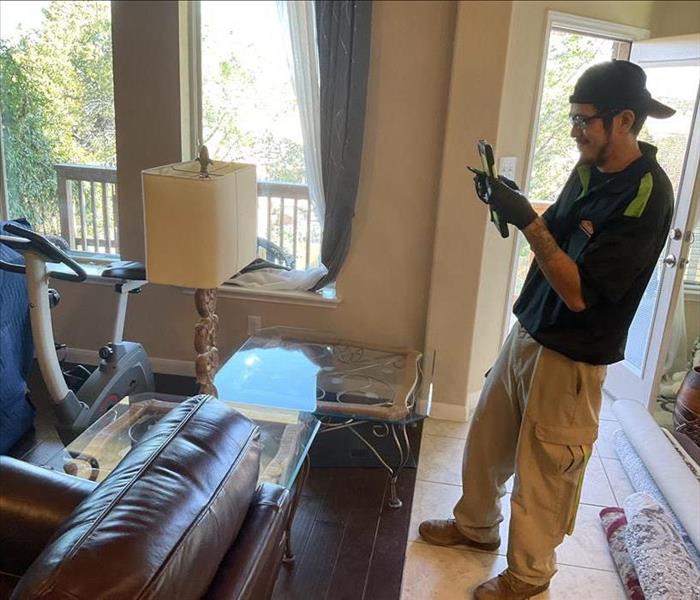 A SERVPRO technician can help assess the damage to your belongings and start on a restoration plan for you!
A SERVPRO technician can help assess the damage to your belongings and start on a restoration plan for you!
When disaster strikes, the aftermath can be overwhelming, especially when it comes to salvaging and restoring fire-damaged furniture. At SERVPRO®, we understand the challenges you may face, and we're here to provide you with valuable tips on how to rescue your cherished belongings. Follow our expert advice to navigate the restoration process effectively and ensure your furniture receives the care it deserves.
Safety First
Before diving into the restoration process, prioritize safety. Ensure the fire department has declared your property safe to enter. Wear protective gear, including gloves and a mask, to guard against harmful particles and contaminants released during the fire.
Assess the Damage
Begin by carefully assessing the extent of the damage to your furniture. Identify items that can be salvaged and those that are beyond repair. Take note of the materials and finishes on each piece, as this information will guide the restoration approach.
Ventilation is Key
Proper ventilation is crucial to mitigate the lingering smell of smoke. Open windows and doors to allow fresh air to circulate. Place fans strategically to improve air circulation and aid in the drying process.
Clean with Care
Start the cleaning process by removing loose soot and debris from the furniture's surface. Use a dry sponge or a vacuum cleaner with a nozzle attachment to gently clean the affected areas. Avoid using water or liquid cleaners at this stage, as they can set the soot into the furniture.
Tackling Smoke Odor
Smoke odor can be persistent, but there are effective ways to combat it. Place bowls of white vinegar or baking soda near the furniture to absorb odors naturally. If the smell persists, consider consulting with a professional restoration service like SERVPRO for advanced odor removal techniques.
Moisture Control
Furniture exposed to fire may retain moisture, leading to mold growth. Use dehumidifiers to control humidity levels and prevent mold formation. Keep the affected area well-ventilated to facilitate the drying process.
Professional Assistance
For extensive fire damage or delicate pieces of furniture, seeking professional assistance is advisable. SERVPRO specializes in fire damage restoration and can provide advanced techniques, including ozone treatments and specialized cleaning solutions, to restore your furniture to its pre-fire condition.
Salvaging and restoring fire-damaged furniture requires a delicate balance of knowledge and expertise. By following these tips and seeking professional help when needed, you can increase the chances of successfully restoring your cherished belongings. At SERVPRO, we're committed to assisting you through every step of the restoration journey. Remember, safety and thorough assessment are the first steps to reclaiming the comfort and beauty of your home after a fire.
Banishing Mold from Your Shower: Effective Removal Strategies
3/6/2024 (Permalink)
Mold in showers is a common issue that can detract from the cleanliness and appeal of your bathroom. Tackling this problem requires a combination of preventive measures and targeted removal strategies. In this blog, we'll explore effective ways to get rid of mold in your shower.
Regular Cleaning Routine
Establish a regular cleaning routine for your shower to prevent the buildup of mold. Wipe down surfaces regularly with a clean, dry cloth or squeegee after each use to remove excess moisture.
Ensure proper ventilation in your bathroom by using exhaust fans or opening windows during and after showers. Adequate airflow helps to reduce humidity, creating an environment less conducive to mold growth.
Remove Organic Matter
Mold thrives on organic matter like soap scum and shampoo residues. Regularly clean and remove these substances from your shower surfaces to eliminate potential food sources for mold.
Utilize natural cleaning solutions such as white vinegar or baking soda. Mix equal parts white vinegar and water in a spray bottle and apply it to mold-affected areas. Allow it to sit for a while before scrubbing with a brush or sponge. Baking soda can be used as a mild abrasive cleaner.
Commercial Mold Removers
Explore commercial mold removers available in the market. Follow the product instructions carefully, and use them in well-ventilated spaces. Wear protective gear if recommended by the product. Hydrogen peroxide is an effective mold remover. Apply it directly to mold-affected areas, let it sit for 10-15 minutes, and then scrub with a brush or sponge. Rinse thoroughly after cleaning.
Preventive Coatings
Consider applying preventive coatings to shower surfaces. Some products create a protective barrier that makes it more difficult for mold to establish itself. Inspect and replace any deteriorating or mold-infested silicone sealant around your shower. Proper sealing prevents water from seeping into crevices where mold can thrive. Conduct regular inspections of your shower area to catch any early signs of mold growth. Addressing the issue promptly can prevent it from spreading and becoming more challenging to remove.
In cases of severe or persistent mold issues, consider hiring professional cleaning services. They have the expertise and tools to address mold problems effectively. SERVPRO® has professional experience and equipment to make your property new again. If you are in need of mold remediation services, don’t hesitate and give us a call today!
Maintaining a mold-free shower requires consistent effort and a combination of preventive measures and targeted cleaning strategies. By incorporating these techniques into your routine, you can banish mold from your shower and create a pristine and inviting bathroom environment. Regular attention to cleanliness and moisture control is the key to enjoying a mold-free sanctuary for your daily grooming rituals.
 Water damage can be an overwhelming experience for any property owner, but documenting the damage is crucial for a successful insurance claim.
Water damage can be an overwhelming experience for any property owner, but documenting the damage is crucial for a successful insurance claim.

 24/7 Emergency Service
24/7 Emergency Service




